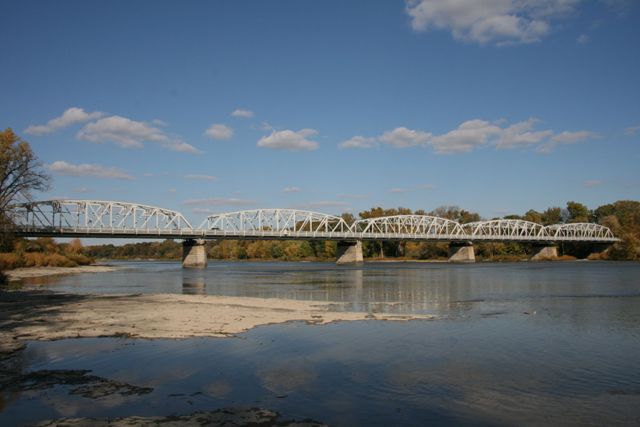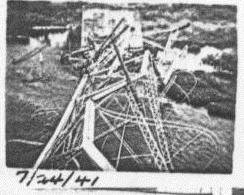We Recommend:
Bach Steel - Experts at historic truss bridge restoration.
BridgeHunter.com Phase 1 is released to the public! - Visit Now
Waterville Bridge

Primary Photographer(s): Nathan Holth and Rick McOmber
Bridge Documented: October 18, 2009 and July 20, 2019
Waterville: Lucas County, Ohio and Wood County, Ohio: United States
1948 By Builder/Contractor: Bethlehem Steel Company of Bethlehem, Pennsylvania
1988
167.0 Feet (50.9 Meters)
846.2 Feet (257.9 Meters)
23.6 Feet (7.19 Meters)
5 Main Span(s)
8702462

View Information About HSR Ratings
Bridge Documentation
This bridge no longer exists!
Bridge Status: Demolished and replaced in 2020.View Archived National Bridge Inventory Report - Has Additional Details and Evaluation
View The Replacement Project Website
With a 1948 construction date, this is a relatively late example of a riveted truss bridge, however the bridge remains very important locally and regionally since it is the largest highway truss bridge in northwestern Ohio. A long, multi-span structure, the bridge is highly attractive because of its size. The bridge lacks v-lacing and lattice except for lattice under the top chord and end post on account of its large number of rolled beams versus built-up beams, which does give it a more plain appearance than other older truss bridges which often had much more built-up beams than this bridge has. However, the bridge makes up for this because of its size, which makes driving across it a very enjoyable experience with a strong "tunnel effect" as it might be called. In addition, the elevation views of this bridge on a sunny day as pictured above are spectacular!
The bridge is built to a Ohio state standard bridge plan.
A major alteration occurred when this bridge's bracing was cut and reconfigured to increase vertical clearance on the bridge.
Although there is some concrete portions as well on the abutments, the overall substructure of this bridge is stone.
This bridge is at risk for demolition and replacement. Although a somewhat late example of its type, Ohio has very few surviving examples of state standard plan truss bridges. As the name implies, state standard trusses were the design of the state in which they were built, and the design details are therefore unique to that state. Therefore, if one state were to demolish all of its state standard truss bridges a historian could not look to other states to find identical design bridges. Therefore it is essential that Ohio preserve some of its state standard plans to prevent an loss of particular portion of transportation heritage.
Information and Findings From Ohio's Historic Bridge InventorySetting/Context The bridge carries a 2 lane road over a stream in a rural setting with scattered 20th century development. The town of Waterville is beyond the west end of the bridge. The prior truss bridge at this location collapsed in 1941 (see photo on old bridge card) [Shown to Right]. Physical Description The 5-span, 846'-long, rivet-connected Parker thru truss bridge is traditionally composed of built-up chords. Some of the diagonals are rolled sections. There are cantilevered sidewalks. The bridge is supported on the ashlar piers and abutments of the prior bridge at this location. The old substructure was widened with concrete. Integrity Deck replacement/repairs, 1988. Summary of Significance The 5-span, Parker thru truss bridge was built in 1948 by the state highway department. It is a late example of what was by 1948 a very common bridge type and design. The bridge is traditionally composed and
exhibits no innovative or distinctive details. Because it is a common solution to a long-span crossing, neither the bridge nor its contexts are historically or technologically significant. It is representative of a bridge type and
design as well as methods of fabrication that had been used for span lengths greater than 100' since the last quarter of the 19th century. Bridge Considered Historic By Survey: No |
This bridge is tagged with the following special condition(s): Unorganized Photos
![]()
Photo Galleries and Videos: Waterville Bridge
Bridge Photo-Documentation
Original / Full Size PhotosA collection of overview and detail photos. This gallery offers photos in the highest available resolution and file size in a touch-friendly popup viewer.
Alternatively, Browse Without Using Viewer
![]()
Bridge Photo-Documentation
Mobile Optimized PhotosA collection of overview and detail photos. This gallery features data-friendly, fast-loading photos in a touch-friendly popup viewer.
Alternatively, Browse Without Using Viewer
![]()
2019 Additional Unorganized Photos
Original / Full Size PhotosA supplemental collection of photos that are from additional visit(s) to the bridge and have not been organized or captioned. This gallery offers photos in the highest available resolution and file size in a touch-friendly popup viewer.
Alternatively, Browse Without Using Viewer
![]()
2019 Additional Unorganized Photos
Mobile Optimized PhotosA supplemental collection of photos that are from additional visit(s) to the bridge and have not been organized or captioned. This gallery features data-friendly, fast-loading photos in a touch-friendly popup viewer.
Alternatively, Browse Without Using Viewer
![]()
Maps and Links: Waterville Bridge
This historic bridge has been demolished. This map is shown for reference purposes only.
Coordinates (Latitude, Longitude):
Search For Additional Bridge Listings:
Bridgehunter.com: View listed bridges within 0.5 miles (0.8 kilometers) of this bridge.
Bridgehunter.com: View listed bridges within 10 miles (16 kilometers) of this bridge.
Additional Maps:
Google Streetview (If Available)
GeoHack (Additional Links and Coordinates)
Apple Maps (Via DuckDuckGo Search)
Apple Maps (Apple devices only)
Android: Open Location In Your Map or GPS App
Flickr Gallery (Find Nearby Photos)
Wikimedia Commons (Find Nearby Photos)
Directions Via Sygic For Android
Directions Via Sygic For iOS and Android Dolphin Browser
USGS National Map (United States Only)
Historical USGS Topo Maps (United States Only)
Historic Aerials (United States Only)
CalTopo Maps (United States Only)



